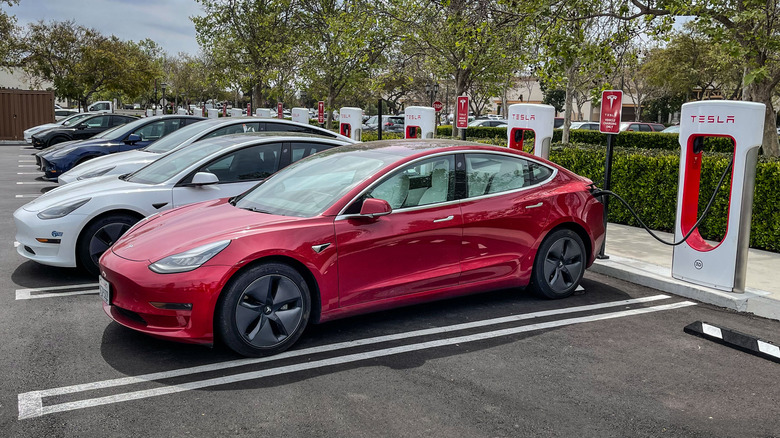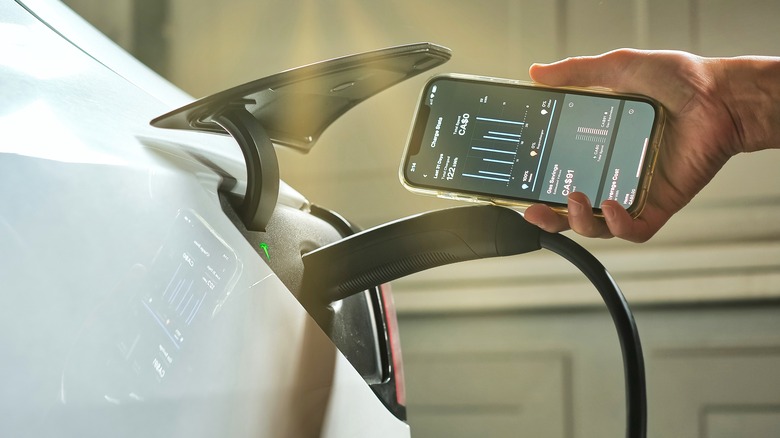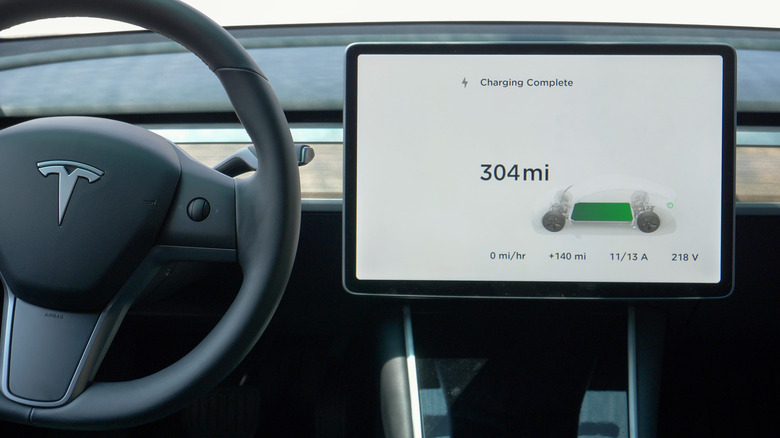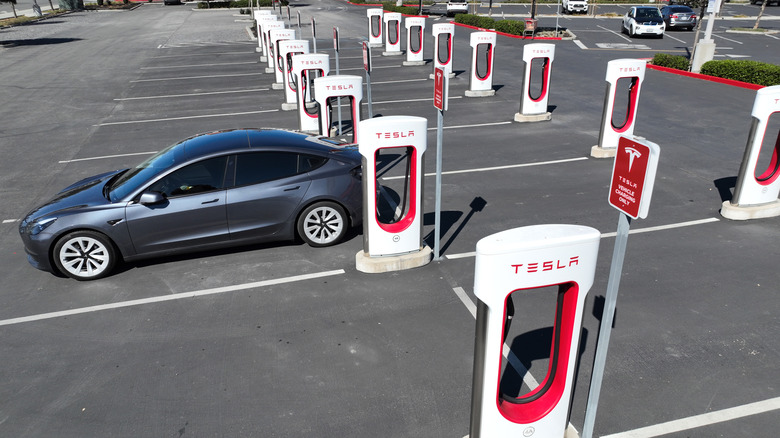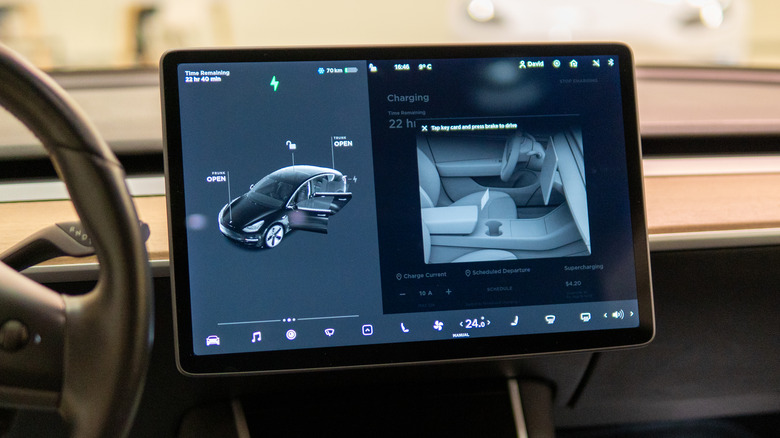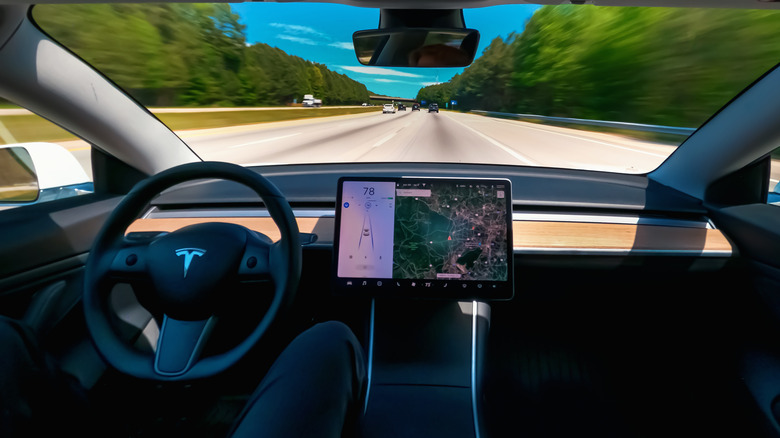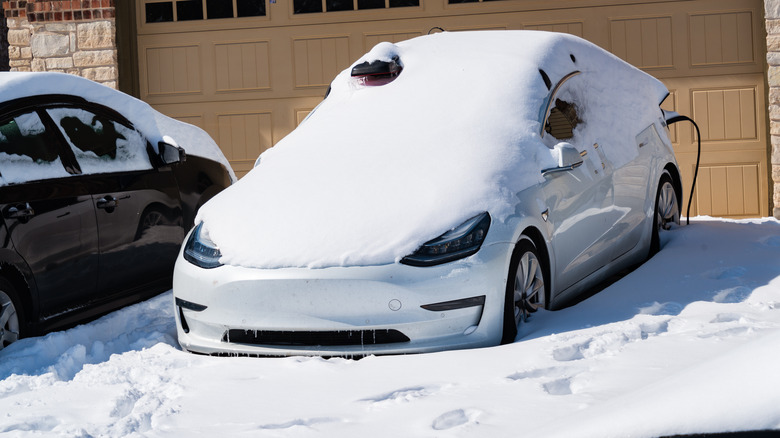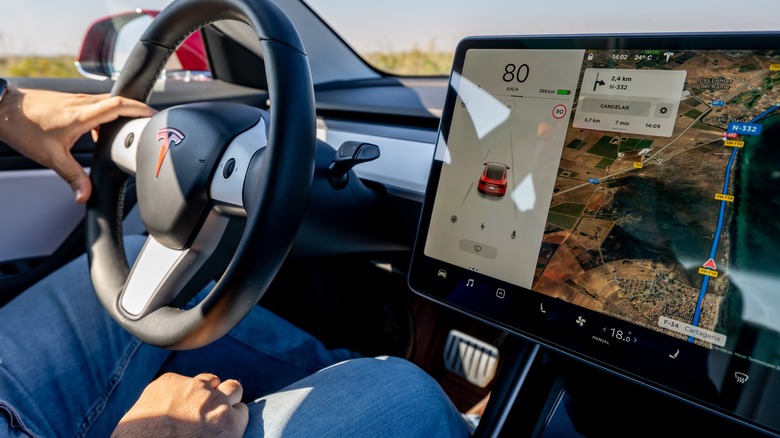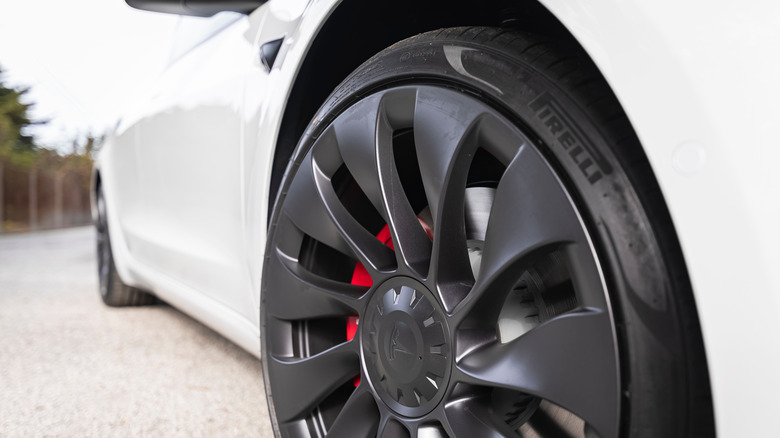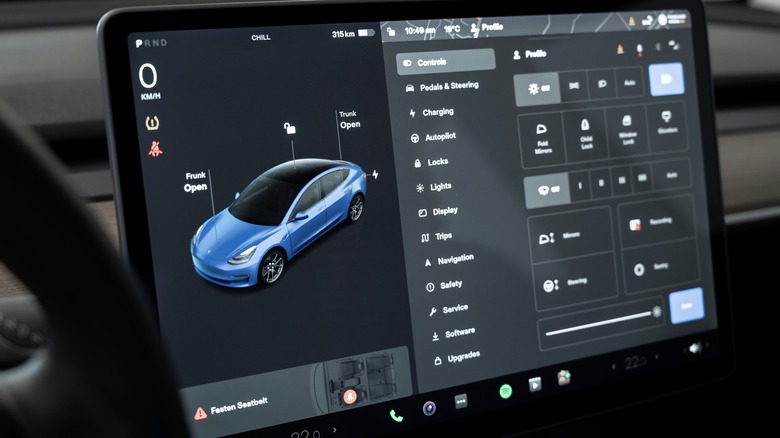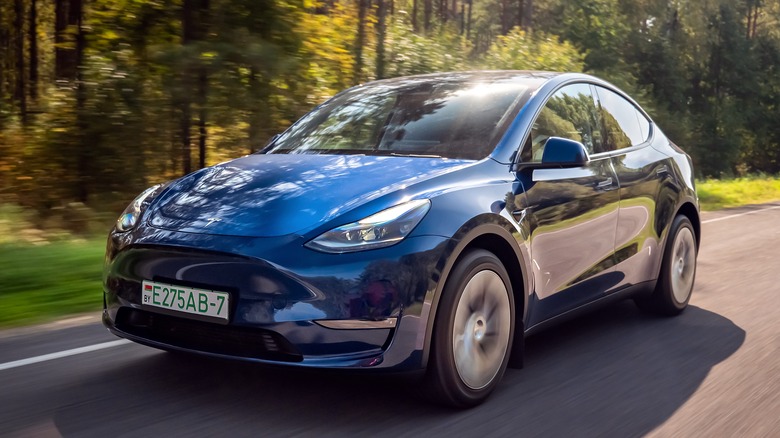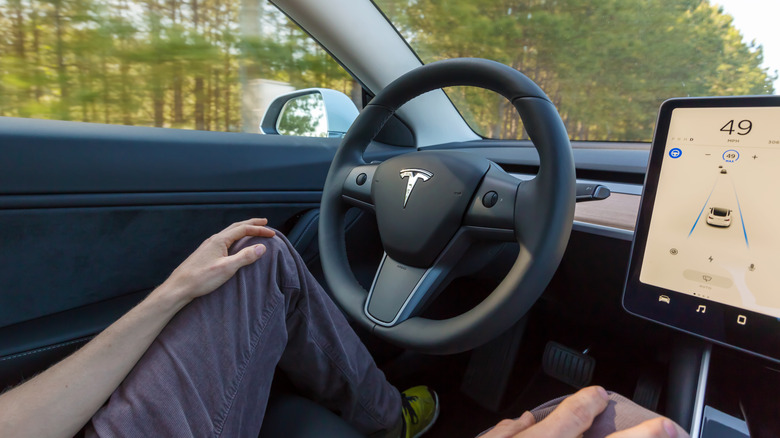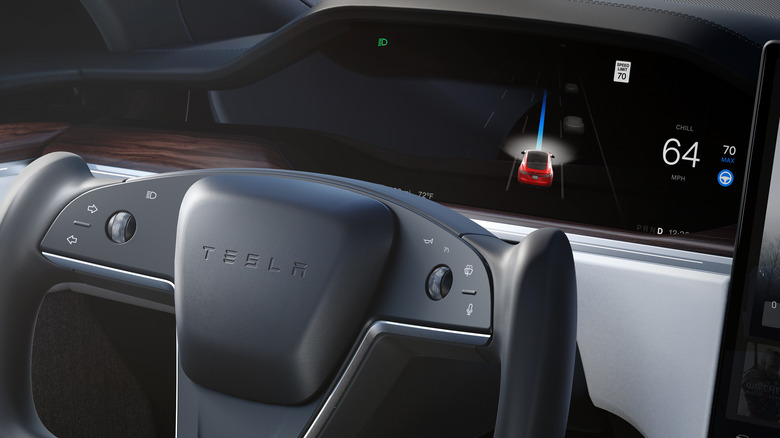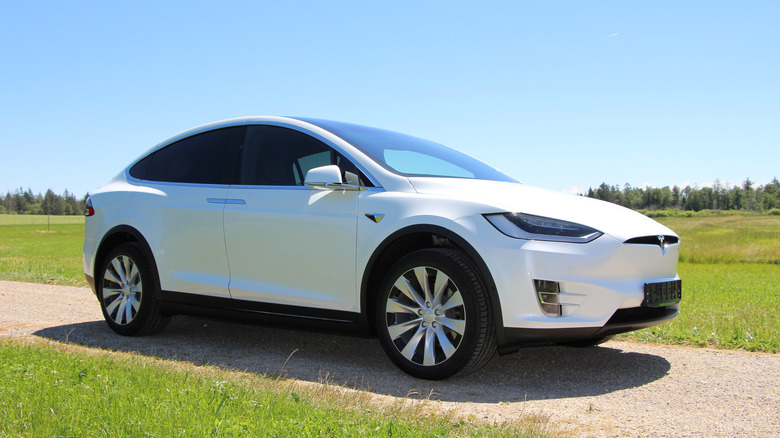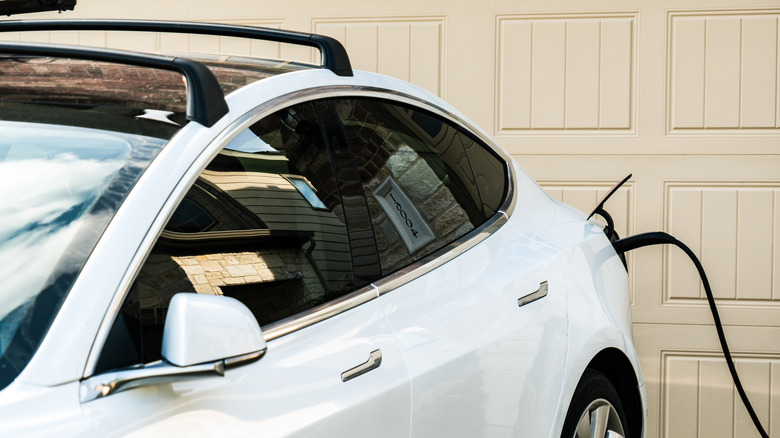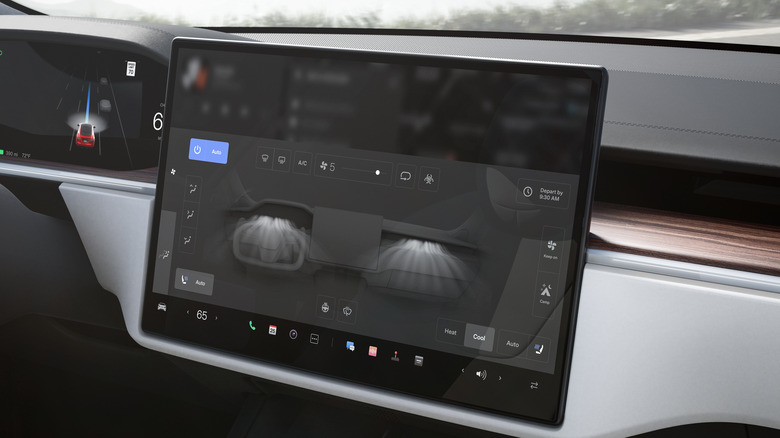15 Expert Tips For Getting More Range Out Of Your Tesla
We've already entered the EV era—it's just a matter of time before every other car uses electricity for propulsion. Spearheading the EV campaign, however, is Tesla. It's no surprise that the vast majority of electric vehicles sold in the United States bear the Tesla logo. In fact, the Model 3, Model Y, Model S, and Model X are so popular that they are becoming household names like the Ford F-150 or Honda Civic.
The most concerning part about EV ownership remains is its range, however, and Tesla's cars–despite their energy efficiency–aren't immune from generating range anxiety. If you are a Tesla owner wondering how to eke out more miles per kWh, though, there's good news: you can improve your driving range by following a few simple tips.
Given how an EV is borderline a gadget on wheels, most battery-saving tips surrounding electronic devices are largely applicable. But since electric cars are not quite the same as a smartphone or hearing aid (for obvious reasons), battery-preserving methods vary accordingly.
Maintain a consistent charging routine with Scheduled Departure
Consistent charging habits can do wonders. Just like your smartphone, topping up the Tesla in a routine fashion can help keep the battery healthy. Lithium-ion batteries are not bulletproof, and degradation will happen over time. While it may not increase the range, the practice will help maintain the existing range and health of the Tesla's battery, the automaker says, thereby increasing longevity.
Another method worth trying is to schedule your departure when plugged in. By informing your Tesla about departure times, the car ensures the cabin is conditioned and achieves the charge limit—depending on how you've personalized the charging feature—just before you set off. To alter the departure settings, enter the Charging section, select Scheduled Departure, and then tap on Schedule. By default, it's turned off.
This feature is particularly useful if you're an office-goer. Setting a departure time to, say, 9:00 AM will ensure your Tesla is topped-up with a preconditioned cabin before work.
Don't charge above 90% or let it fall below 20%
Just like smartphones, State of Charge (SoC) is crucial when it comes to charging your EV (via Electrek). Since Teslas use Li-ion cells, it's important not to let them overcharge or remain undercharged. This helps with slowing battery degradation and increasing longevity.
The percentages are usually a topic of intense debate. It's commonly recommended not to exceed 90%, whether for a phone or a car. However, some find the number high and suggest charging only up to 85%. On the other hand, it's advised not to let the battery fall below 20%, but you'll find other people suggesting that lower limit should be 15%.
Whatever the case, the idea behind this is to keep the battery in its optimum range and reduce the number of charge cycles it goes through. Draining the battery completely and then recharging it to maximum capacity accounts for one charge cycle. Fully discharging and charging puts a lot of strain on the battery. Instead, try topping up your Tesla whenever you can: this leads to fewer charge cycles over a period of time. The lesser the charge cycles, the longer the battery holds its rated capacity.
Use the Supercharger facility sparingly
On the topic of holding the rated capacity, it's important to understand that relying on fast charging (such as at Tesla Superchargers) may not be that good for your car's battery. Because DC Superchargers use a higher voltage than normal wall charging, your Li-ion battery is subjected to much higher temperatures which, over time, can lead to battery degradation.
Although the onboard Active Thermal Management system can prevent the cells from overheating, it cannot reverse the chemistry of a Li-ion cell. According to EVjuicedup, it is estimated that for every 10,000 miles driven your Li-ion battery degrades by 1.9%. Tesla, for its part, states that its batteries are capable of retaining 70% capacity over the standard 8-year warranty period.
For optimum battery health, Tesla recommends charging more regularly on a low-voltage charger, and using Superchargers only when it is absolutely necessary. Tesla installed Superchargers to allow its owners the freedom of long-distance motoring without having to put up with range anxiety: the ideal recommendation is quick top-ups at those stations between long journeys, and otherwise sticking to the wall connector.
Keep the Tesla plugged in while preheating/cooling
Another recommendation from Tesla is to keep your car plugged in at all times when not in use. If you're living in a hot or cold weather climate and require preconditioning the cabin, it's wise to use the preheating/cooling feature only when plugged in. Tesla allows you to remotely activate the climate control of your car via the Tesla app, but if your EV isn't plugged in at the time, it'll be using battery power to heat or cool the interior.
Having the Tesla precondition the cabin while plugged in ensures energy is drawn from the grid and not the battery. When drawing power from a charger, your Tesla will bypass the circuit to directly use the supplied electricity, instead of relying on its Li-ion cells.
Not only does this reduce degradation, but using such features when plugged in allows the battery to remain within optimum range when you set off. As for concerns about overcharging the battery, Tesla's software will limit charging past the safe capacity to prevent any damage or premature aging.
Consider using Autopilot and drafting for long trips
Much like how cruise control helps in eking out better miles per gallon (mpg) on the highway in gas cars, using Tesla's Autopilot can help increase your car's driving range (via Tesla Motors Club). Essentially, Autopilot runs the car in its optimum settings and uses minimum throttle. Efficient acceleration and braking are better achieved by a computer rather than a human being: it's just how things are. Your Tesla is smart enough to calculate and optimize its settings during commutes, especially long journeys. But the situation becomes quite different when you encounter headwinds.
Headwinds and crosswinds can lead to your Tesla using more energy in maintaining a certain speed. In this scenario, switching to manual controls and drafting–otherwise known as slipstreaming, where you take advantage of the reduction of aerodynamic drag from the car ahead–can deliver better range, provided of course that there are other cars on the road.
Keeping 1-2 car lengths away can bring about a positive effect on your overall driving range. However, it's important to note that drafting will involve bringing you close to other vehicles, and you'll need to stay attentive in order to maintain safety. Slippery road surfaces, such as from rain or ice, increase stopping distances during emergency braking, for example, making drafting more dangerous. If done with caution, in the right conditions, the exercise can significantly reduce wind resistance and improve your Tesla's available range.
Avoid overnight parking in cold temperatures
Lithium-ion batteries are very temperature-sensitive, and cold climates are known to affect the available range and battery longevity of electric cars. Storing your Tesla somewhere with warmer temperatures can help maintain optimum battery performance.
"Batteries are like humans," says Anna Stefanopoulou, director of the University of Michigan's Energy Institute (via Wired). Batteries will struggle to deliver their peak performance at temperatures below 40 or above 115 degrees Fahrenheit. They tend to operate best between 60 to 80 degrees. According to Stefanopoulou, the electrolyte inside the battery cells becomes more sluggish as the temperature drops which, in turn, slows down the charging and discharging process.
If you find a snowflake icon near the range indicator of your Tesla, it means a portion of the battery charge is unavailable as the battery itself is cold. This is done as a safety measure to protect the battery, and the icon will go away once the pack is sufficiently warm. According to Wired, an EV will typically cover around 20% fewer miles in cold weather versus warmer and more EV-friendly climates.
Try the built-in navigation for picking charging stops (preconditions the battery beforehand)
Temperature has a big impact on driving range and charging speeds, whether too hot or too cold. If you're taking a long trip during winter, for example, it's advised that you stick to the car's built-in sat-nav, particularly when you're looking for a Supercharger.
Even if you know where the Supercharger is located without directions, letting the navigation system know where you're headed has some advantages in the background. The system preconditions the battery as it approaches a Supercharger, warming it so that by the time you arrive to plug in, it's in the optimum range for the quickest charge times.
It's worth noting that preconditioning will increase the draw on the battery as you head to the Supercharger, so you'll arrive with less charge than you would had your Tesla not warmed the pack ahead of time. The idea is that the time saving from reaching peak charging speeds with a preconditioned battery are worth it, and offset the slightly greater charge the car requires. If you really don't want to use preconditioning, you can tap the notification about it when you set a Supercharger destination to cancel it (via Tesla Motors Club).
Maintain tire pressures, alignment, and install Aero Wheel Covers
Just like any automobile, tire pressure and wheel alignment are crucial when it comes to efficiency. Teslas are no exception. You'll find the recommended tire pressures inside the driver-side door jamb. Unlike most mainstream cars, Teslas use slightly higher tire pressures (42-45 PSI), depending on the model.
Running your Tesla with under-inflated tires will lead to more battery consumption. The same holds for wheel alignment: if misaligned, there's more friction/rolling resistance, and you'll eventually end up spending more on replacing tires.
Another recommendation is to use the aero wheel covers if your Tesla is supplied with them. While opinions vary on the aesthetics, aero covers do help with increasing efficiency. Putting them on, especially for long journeys and highway trips, can bring about a noticeable difference. According to Car and Driver, aero wheels improved the Model 3's efficiency by an average of 3.4%, yielding an additional 10 miles of range.
Take advantage of Regenerative braking
Regenerative braking can add a few miles of extra range (via Way). One-pedal driving, as it is commonly called, recuperates the surplus charge generated during deceleration and charges the battery, and does so more aggressively when you lift off the accelerator pedal. As the name suggests, you're essentially using one pedal to modulate speed and slowing, with braking fully or partially (depending on the settings) taken care of by your Tesla. The intensity of this brake-regen function can be adjusted, should you find the system to be abrupt or jerky.
Head over to Controls > Driving (or Pedals & Steering, as seen in newer models) and set Regenerative Braking to 'Low' for less intrusion. By default, your Tesla will have its Regenerative Braking set to 'Standard.' Or, you can go super-aggressive on the regen by selecting 'Hold' under Stopping Mode. This extends the regenerative braking function to lower speeds, Tesla says, and uses the friction brakes to hold the car when fully stopped, unlocking a true one-pedal driving experience. You can also try experimenting with 'Creep' and 'Roll' to find which one suits your driving style better.
Don't drive pedal-to-the-medal, try the Chill Mode
Another way to avoid excessive energy drain is to simply drive at moderate speeds. Aggressive acceleration will deplete your Tesla's battery faster, but if you struggle to restrain your heavy right foot, you could try using the 'Chill' mode. You can find the setting by going to Controls > Driving (or Pedals & Steering). The default setting on your Tesla is 'Standard' for acceleration; 'Chill' mode, on the other hand, limits the available power and torque, thereby improving efficiency. Unlike internal combustion cars, EVs are not particularly great at economy when cruising at highway speeds. If you want more miles from your Tesla, use the throttle judiciously. Yes, the instant torque is fun and exciting, but it does take a hit on the driving range.
Other potential scenarios that affect your range include uphill travel and stop-and-go traffic (via Tesla). However, you can recoup the energy spent going uphill using regenerative braking, i.e., if you come across a downhill slope immediately after. Stop-and-go traffic, which is usually very inefficient in an internal combustion vehicle, can be far more frugal in an electric car, since the motors automatically switch off when the EV isn't moving. However, if you're making lots of short trips, Tesla warns that you could see a greater-than-expected impact on range, because the car will condition the cabin and battery each time.
The in-car Energy app helps
The Energy app is designed to help you maximize range and efficiency through suggestions based on your driving habits (via Tesla). The app basically reports directly from the battery management system, flagging the things that are using up energy whether that be driving style, battery conditioning, climate, and so on. You can access the Energy monitor by opening the apps menu and clicking on the Energy icon on the dashboard touchscreen, or through the Tesla mobile app.
Either way, there's a graphical representation of your Tesla's energy consumption, along with an approximate range and the range you've been averaging so far based on your driving style. You can change the projected estimates by cycling through the tabs labeled 5 miles, 15 miles, and 30 miles, adjusting the historic distance that the EV takes into account as it calculates efficiency. Though these are just estimates, they can be useful to figure out just what is affecting your Tesla's driving range. If your driving style has significantly affected efficiency, meanwhile, the app can even offer recommendations, provided it's running the latest version.
Switching on Speed assist and using Range Mode
If you're used to 'Autopilot,' you'll probably be familiar with the Speed Assist feature. For those who aren't, go to Controls > Autopilot > Set Speed. Setting a predefined limit (below the actual speed limit) can help save you from getting a ticket. Additionally, it helps the Tesla use less energy as the speed is now optimally governed by the computers instead of you. Tesla offers you more customization by controlling how you are warned or the option to disable all related warnings. Set the toggle to 'Chime' or 'Display,' and they do as advertised. We suggest setting how the speed limit is calculated to 'Relative,' with an 'Offset' of 5 mph.
Another battery-saving feature worth enabling is the Range Mode. Unfortunately, you won't find it in the Model 3 or Model Y. However, if you own a Model S or Model X, then turning on Range Mode conserves energy by limiting the power of the climate control system and turning off the signature lights. In an all-wheel-drive vehicle, the feature also optimizes torque distribution between the motors for enhanced efficiency.
Adjust the air suspension setting (if equipped)
This is yet another battery tip reserved for the more expensive Model S and Model X. Aerodynamic drag is often overlooked by many and is something that varies across body styles. While SUVs help with better visibility and added practicality, the higher ground clearance induces more turbulence (or drag) during highway speeds, affecting fuel efficiency or battery range in the case of an EV.
Tesla recommends altering the suspension settings to improve the available range. For Model S or Model X with adjustable air suspension, changing the settings to 'Low' or 'Very Low' is advised for reduced aerodynamic drag. The impact on range, however, will be more noticeable in the taller Model X than the Model S. In addition to better aerodynamics, a lower vehicle height makes it easier to load or unload cargo, offer easy ingress and egress, along with improved handling. You can adjust the suspension settings by heading over to Controls > Suspension, but make sure to have your foot firmly pressed on the brake pedal first.
Get rid of unnecessary cargo and raise all windows
Specific model-depending, your Tesla could well be among the most aerodynamically-efficient cars in today's market (via Carwow). To keep it as close to its rated coefficient of drag, though, it's advised not to drive with the windows rolled down. For better aero management and range, it's best to fully raise all the windows of your Tesla, especially at highway speeds. Not only does it offer more cabin insulation, but it smoothens the airflow around the car, allowing your Tesla to slip through with minimal wind resistance. Additionally, raising the windows help vastly reduce the chances of any unwanted contaminants entering the car.
On the topic of aerodynamic drag, it's important you remove items like a roof box or cargo rack when not in use to improve range. Plus, make sure there isn't any unnecessary cargo inside the rear trunk. Unless it's a long trip, the only thing you really need inside the trunk is the charging cable. More weight requires more energy to move.
This next battery tip might be a bit extreme, but as they say, every drop counts. If you can—try charging your phone at home or work. Although hardly a power-hungry exercise, phone charging can be avoided—if possible—for those extra watt-hours, recommends Teslastir.
Try disabling features you don't need
Tesla offers you several connected features in the name of convenience and safety. While these quality-of-life-improving features may help improve the Tesla ownership experience, they can also use energy unnecessarily. Features such as Headlights After Exit, Sentry Mode, and Cabin Overheat Protection can all impact range.
Using the external cameras, the Sentry Mode adds a layer of protection by continuously monitoring the environment around the car to record any suspicious activity. If your Tesla is left for eleven days with Sentry Mode turned on, you'd likely return to a dead Tesla (via Jerry). In contrast, Teslas parked with Sentry Mode turned off can go up to twenty days without needing a charge. This 'vampire drain' can be an issue if you leave your car unattended while on holiday, and you may prefer to turn Sentry Mode off, either from within the car (Controls > Sentry) or via the Tesla App.
Although an excellent safety and comfort feature, Cabin Overheat Protection is another item that can drain your battery. Try disabling the function when you're running low on charge or to simply prevent parasitic battery drain. Select Controls > Safety > Cabin Overheat Protection to toggle the option on or off. After all, you probably won't be needing the Sentry Mode if your house has security cameras, or the Cabin Overheat Protection feature if you park in a garage or an underground car park.
